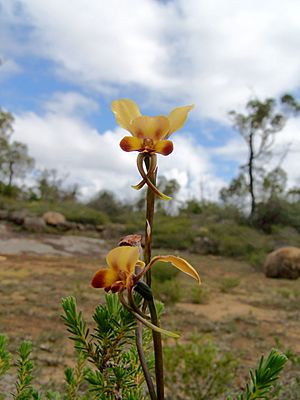Winter donkey orchid facts for kids
The winter donkey orchid (Diuris brumalis) is a special type of orchid that grows only in the south-west part of Western Australia. It's one of the first donkey orchids to bloom each year in that area. Even though its flowers look like they might offer a treat, they actually trick insects into visiting without giving them any food!
Quick facts for kids Winter donkey orchid |
|
|---|---|
 |
|
| Scientific classification | |
| Genus: |
Diuris
|
| Species: |
brumalis
|
Contents
What Does It Look Like?
The winter donkey orchid is a plant that grows from a tuber (a bit like a potato underground). It's a perennial herb, meaning it lives for more than two years and doesn't have a woody stem. These orchids usually grow to be about 20 to 50 centimeters (8 to 20 inches) tall.
Each plant has two or three leaves that grow from its base. These leaves are about 15 to 20 centimeters (6 to 8 inches) long and 0.8 to 1 centimeter (0.3 to 0.4 inches) wide.
The plant produces between three and fifteen pretty yellow and brown flowers on its stem. Each flower is about 2 to 4 centimeters (0.8 to 1.6 inches) long and 2 to 3 centimeters (0.8 to 1.2 inches) wide.
Flower Parts
Orchid flowers have special parts:
- The dorsal sepal is the top part, standing upright. It's about 0.6 to 1.2 centimeters (0.2 to 0.5 inches) long and 0.7 to 1.5 centimeters (0.3 to 0.6 inches) wide.
- The lateral sepals are greenish and hang downwards. They are about 1.2 to 2.4 centimeters (0.5 to 0.9 inches) long and 0.2 centimeters (0.08 inches) wide.
- The petals look like ears and stand upright. They have a stalk about 0.2 to 0.6 centimeters (0.08 to 0.2 inches) long and a blade (the main part) about 1 to 1.8 centimeters (0.4 to 0.7 inches) long and 0.6 to 1.2 centimeters (0.2 to 0.5 inches) wide.
- The labellum is the special lip-like petal. It has three parts, called lobes. The side lobes are about 0.6 to 1 centimeter (0.2 to 0.4 inches) long. The middle lobe is shaped like a wedge and is about 0.5 to 0.9 centimeters (0.2 to 0.4 inches) long. There's also a single yellow ridge in the middle of the labellum.
These orchids usually flower from June to August, which is winter in Australia.
How It Was Named
The Diuris brumalis was first officially described in 1991 by a botanist named David Jones. He found a sample of the plant near a place called Kalamunda.
The second part of its scientific name, brumalis, comes from a Latin word. It means "of the shortest day," which refers to how this orchid flowers during the winter, when the days are shortest. That's why it's called the "winter donkey orchid"!
Where Does It Live?
The winter donkey orchid grows in areas with shrubs and forests. You can find it between Jurien Bay and Collie in Western Australia. These areas include the Avon Wheatbelt, Jarrah Forest, and Swan Coastal Plain regions.
How It Interacts with Nature
The flowers of the winter donkey orchid look a lot like the flowers of some other plants, such as Oxylobium and Daviesia species. These other plants offer nectar or pollen as a reward to insects that visit them.
Interestingly, the winter donkey orchid attracts the same native bees that visit those other plants. However, the orchid doesn't give the bees any nectar or pollen! It's a clever trick to get pollinated without offering a food reward.
Is It Endangered?
The Western Australian Government's Department of Parks and Wildlife has classified Diuris brumalis as "not threatened." This means it's not currently in danger of disappearing.

